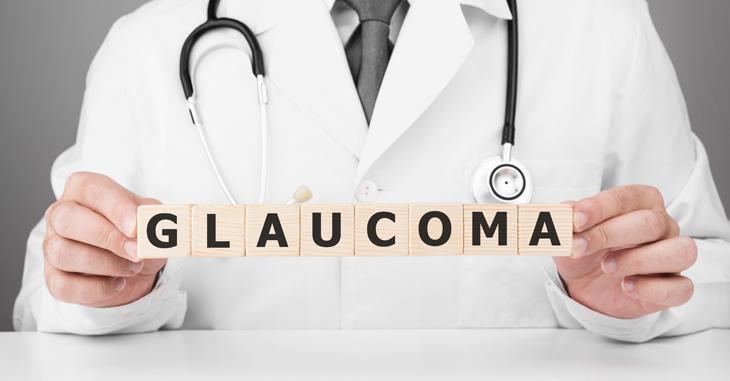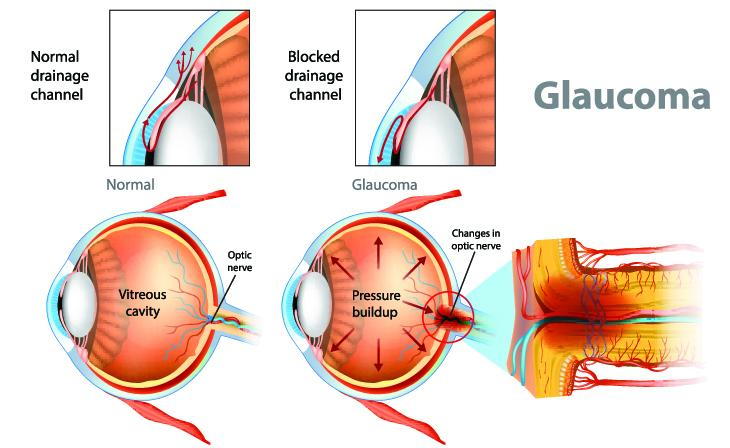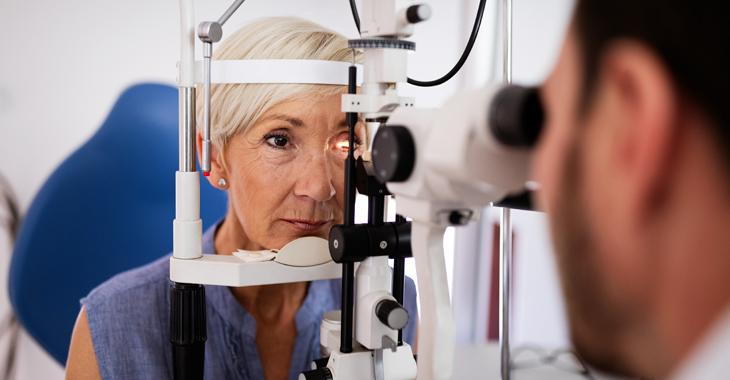- Home >
- The Causes, Symptoms, and Treatments of Glaucoma
The Causes, Symptoms, and Treatments of Glaucoma

Glaucoma refers to a group of eye diseases that damage the optic nerve, causing vision loss. Currently, it is the second leading cause of blindness in the United States.
What Is Glaucoma?
Usually, when we talk about glaucoma in America, we’re referring to the type called open-angle glaucoma. Open-angle glaucoma causes a build-up of fluid in your eye. It puts pressure on your optic nerve and can eventually cause you to lose your eyesight.
While there’s no current cure for glaucoma, this chronic eye disease can be managed and the symptoms addressed to slow progression. Early diagnosis is key.
Open-angle glaucoma happens slowly. Over time, fluid backs up in the eye. This happens because the fluid, or aqueous humor, generated by your eye cannot drain as it should. Usually, this is because something somewhere is clogging your system.
This condition causes intraocular pressure to develop, which is damaging over time. Many people with this type of glaucoma don’t know they have it because it happens so slowly that symptoms are minimal. Eventually, however, blind spots develop. This may be the first sign that something is wrong.
The Glaucoma Research Foundation estimates over 3 million Americans have glaucoma, though only half of them have sought treatment.
How Do I Know If I Have Glaucoma?

Regular eye exams are your best defense against glaucoma. Early detection and diagnosis are key to having a more successful outcome. By treating glaucoma early, your opthalmologist can slow the damaging effects. Because this disease often shows no symptoms early on, seeing your eye doctor for routine visits is the best way to discover whether you have glaucoma.
As glaucoma develops, the symptoms usually become more noticeable. They may include:
- Loss of peripheral vision
- Blind spots
- Halos around bright lights
- Narrowing vision (tunnel vision)
- Bloodshot eyes
- Eye pain
However, not everyone who develops glaucoma will experience the same symptoms. And other forms of glaucoma may be associated with different symptoms. For these reasons, it’s important to make regular appointments for eye exams, especially if you’re over the age of 50.
It’s also important to note certain risk factors increase your chances of developing glaucoma. If this condition runs in your family, you may be more susceptible. You are also more at risk if you have other chronic, uncontrolled conditions such as diabetes, high blood pressure, or heart disease. The risk of glaucoma goes up as you age, and if you are African-American or Latino, your odds are higher as well.
How Will My Eye Doctor Diagnose Glaucoma?

Your eye doctor will perform tests to determine whether you have glaucoma. These tests measure five different aspects of your eyes and vision, including:
- The amount of pressure inside your eye
- The appearance (shape and color) of your optic nerve
- The thickness of your cornea
- Your complete field of vision
- The angle at which your iris meets your cornea
Tests utilize tools such as dilating eye drops, quick puffs of air, pinpoint lights, a contact lens, or a probe. All tests are non-invasive and basically painless. You may experience tearing, however. You may also experience slight sensitivity to light afterward. Your ophthalmologist may give you disposable sunglasses to wear home.
Usually, your eye care specialist will begin with a test called tonometry. This uses a small puff of air to measure your intraocular pressure. They may then go on to use dilating eye drops that help them better see your optic nerve through an imaging machine. If these tests show nothing unusual, your exam may stop there.
What Are the Current Treatments for Glaucoma?
Treatment for glaucoma begins with managing the conditions that contribute to it. This means if you have diabetes or high blood pressure, bringing them under control may help slow vision loss. Prescription eye drops are another option. These lower the pressure in your eye, taking the strain off your optic nerve.
Your doctor may also use a laser procedure to drain excess fluid from your eye. Ultimately, you may need surgery to help the fluid drain from your eyes as it should. Surgery for glaucoma is minimally invasive. Most patients can have it done in one or two hours and go home the same day.
Stay On Top of Your Eye Exams
If it has been more than a year since you’ve seen your eye doctor for a routine exam and glaucoma screening, it’s time to make an appointment. Or if you’re experiencing unexplained changes in your vision, this is another good reason to call your eye doctor.
Glaucoma is a serious eye disorder, but you can effectively manage it. The sooner you’re diagnosed, the more optimistic your outcome.

Glaucoma refers to a group of eye diseases that damage the optic nerve, causing vision loss. Currently, it is the second leading cause of blindness in the United States.
What Is Glaucoma?
Usually, when we talk about glaucoma in America, we’re referring to the type called open-angle glaucoma. Open-angle glaucoma causes a build-up of fluid in your eye. It puts pressure on your optic nerve and can eventually cause you to lose your eyesight.
While there’s no current cure for glaucoma, this chronic eye disease can be managed and the symptoms addressed to slow progression. Early diagnosis is key.
Open-angle glaucoma happens slowly. Over time, fluid backs up in the eye. This happens because the fluid, or aqueous humor, generated by your eye cannot drain as it should. Usually, this is because something somewhere is clogging your system.
This condition causes intraocular pressure to develop, which is damaging over time. Many people with this type of glaucoma don’t know they have it because it happens so slowly that symptoms are minimal. Eventually, however, blind spots develop. This may be the first sign that something is wrong.
The Glaucoma Research Foundation estimates over 3 million Americans have glaucoma, though only half of them have sought treatment.
How Do I Know If I Have Glaucoma?

Regular eye exams are your best defense against glaucoma. Early detection and diagnosis are key to having a more successful outcome. By treating glaucoma early, your opthalmologist can slow the damaging effects. Because this disease often shows no symptoms early on, seeing your eye doctor for routine visits is the best way to discover whether you have glaucoma.
As glaucoma develops, the symptoms usually become more noticeable. They may include:
- Loss of peripheral vision
- Blind spots
- Halos around bright lights
- Narrowing vision (tunnel vision)
- Bloodshot eyes
- Eye pain
However, not everyone who develops glaucoma will experience the same symptoms. And other forms of glaucoma may be associated with different symptoms. For these reasons, it’s important to make regular appointments for eye exams, especially if you’re over the age of 50.
It’s also important to note certain risk factors increase your chances of developing glaucoma. If this condition runs in your family, you may be more susceptible. You are also more at risk if you have other chronic, uncontrolled conditions such as diabetes, high blood pressure, or heart disease. The risk of glaucoma goes up as you age, and if you are African-American or Latino, your odds are higher as well.
How Will My Eye Doctor Diagnose Glaucoma?

Your eye doctor will perform tests to determine whether you have glaucoma. These tests measure five different aspects of your eyes and vision, including:
- The amount of pressure inside your eye
- The appearance (shape and color) of your optic nerve
- The thickness of your cornea
- Your complete field of vision
- The angle at which your iris meets your cornea
Tests utilize tools such as dilating eye drops, quick puffs of air, pinpoint lights, a contact lens, or a probe. All tests are non-invasive and basically painless. You may experience tearing, however. You may also experience slight sensitivity to light afterward. Your ophthalmologist may give you disposable sunglasses to wear home.
Usually, your eye care specialist will begin with a test called tonometry. This uses a small puff of air to measure your intraocular pressure. They may then go on to use dilating eye drops that help them better see your optic nerve through an imaging machine. If these tests show nothing unusual, your exam may stop there.
What Are the Current Treatments for Glaucoma?
Treatment for glaucoma begins with managing the conditions that contribute to it. This means if you have diabetes or high blood pressure, bringing them under control may help slow vision loss. Prescription eye drops are another option. These lower the pressure in your eye, taking the strain off your optic nerve.
Your doctor may also use a laser procedure to drain excess fluid from your eye. Ultimately, you may need surgery to help the fluid drain from your eyes as it should. Surgery for glaucoma is minimally invasive. Most patients can have it done in one or two hours and go home the same day.
Stay On Top of Your Eye Exams
If it has been more than a year since you’ve seen your eye doctor for a routine exam and glaucoma screening, it’s time to make an appointment. Or if you’re experiencing unexplained changes in your vision, this is another good reason to call your eye doctor.
Glaucoma is a serious eye disorder, but you can effectively manage it. The sooner you’re diagnosed, the more optimistic your outcome.
Contact Us
Thank you. Your submission has been sent.

